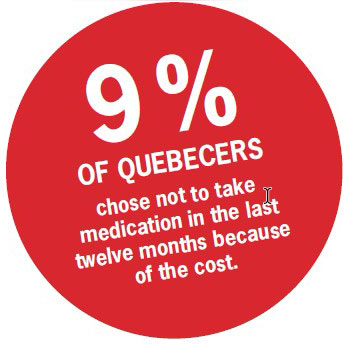The amounts billed are at least 35% higher for the privately insured than on the public plan. Many reasons are behind this price difference. Among them: pharmaceutical fees. On the public plan, those are regulated. A pharmacist renewing a prescription, for example, charges $8.96 to the client. That amount is fixed and stays the same from one pharmacy to the next.
On the other hand, if the client is covered by a private insurance, the pharmacists are free to decide their fee. To renew a prescription, it can be up to 225% higher!
Other elements that make the privately insured’s bill go up include:
- average administrative fees about 10 times higher than on the public plan;
- a lower utilization rate of generic medicines;
- a 9% tax applied on premiums.
“This situation is unacceptable, claims Sonia Ethier, CSQ President. It’s proof that the Québec public-private prescription drug insurance plan has not reached one of its main objectives, which is to better control the costs. We can’t ask people to choose between medicine and food.”
Fairness problems
The current public-private plan presents fairness problems. In the public plan, for example, premiums are calculated in terms of disposable family income. In private plans, they are instead set in terms of experience. The more drugs claims, the higher the premium. This situation is detrimental to members of groups in which workers have more health problems.
Moreover, in private plans, each insured person of a group pays the same premium, no matter the salary. Workers of a modest income or precarious status are sadly penalized.
Costlier here than elsewhere
Canada is the developed country where the costs of drugs are the highest. Here, 100 dollars of patented drugs only cost $81 abroad, and only $67 if they are generic.
The highest costs here are mainly the result of historical attempts to encourage the growth of the pharmaceutical industry. However, the results in terms of job creation did not happen.
Premiums which keep going up
Over the last twenty years, the annual average increase of collective insurance premiums is between 6.5 and 7.5%.
The premium increase also touches people insured with the Régie de l’assurance maladie du Québec’s public plan. For example, between 1997 and 2019, the annual premium went from 175 to 616 dollars. Such an increase largely exceeds the inflation and wage increases granted, either in the private or public sectors.
 The solution?
The solution?
“The implementation of an entirely public prescription drug insurance plan, like the CSQ has been demanding for the past twenty years, would allow for a universal coverage, offering the same level of protection to everyone as well as a fair access to prescription drugs, and improve performance of the health system,” states Sonia Ethier.
Of all the developed countries, Canada is the only one, apart from the United States, not to offer such coverage. However, the federal government is thinking about it.
In Canada, there are some 70 public prescription drug insurance plans, 113,000 private plans and 130 health insurance providers. The creation of a single public buying group could offer a bigger negotiation power with the pharmaceutical companies.
“A better cost control would generate important annual savings for Québec, continues Sonia Ethier. The savings represent between $811 million and $3,800 million that would be reinvested in public services, in particular in the health and social services network, where the needs are huge. Ultimately, the entire population would benefit.”
The union movement mobilizes
To convince the governments that it’s time to switch to a universal and public insurance plan, the CSQ, FTQ and CSN are joining forces in La pièce manquante campaign. In the coming months, they will hold various awareness-raising activities to inform the population. To learn more, visit: assurancemedicaments/lacsq.org.

